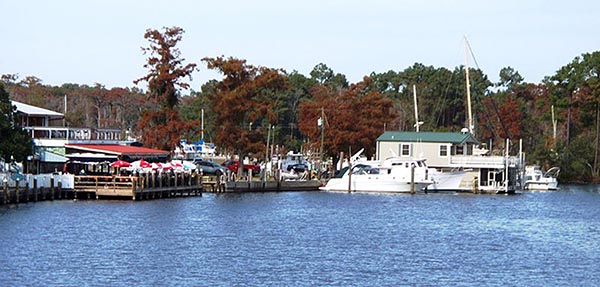Madisonville
Madisonville became an important Louisiana shipbuilding center, boasting four shipyards by the late nineteenth century.

Courtesy of Wikimedia Commons
Madisonville Waterfront. Ramsey, Richard David (Photographer)
Madisonville was one of the nineteenth-century resort communities on Lake Pontchartrain’s north shore favored by New Orleanians as a weekend retreat as well as a summertime escape from the threat of yellow fever. Because of its location beside the Tchefuncte River, just two miles above its entrance into Lake Pontchartrain, Madisonville also became an important shipbuilding center, boasting four shipyards by the late nineteenth century. During World War I the Jahncke Shipyard employed more than 2,000 workers; since 2002 it has been the site of the Lake Pontchartrain Basin Maritime Museum and Research Center. After World War II the shipbuilding industry declined and today Madisonville is a tranquil small town, catering mostly to leisure boating, as typified by the Wooden Boat Festival on its downtown riverfront every autumn. One remnant of the town’s shipbuilding days is a former boardinghouse (703 Main St.), built of wood circa 1880, which was originally a private residence before being converted for lodgers in the 1920s. It is now a remodeled private residence. Madisonville’s former town hall (201Cedar St.), a small two-story brick structure built in 1911, accommodated a jail on the ground floor.An exterior double staircase rises to the second-floor, which now serves as a museum. The wooden house at 206 Covington Highway, constructed in 1911 for Theodore Dendinger, who was prominent in lumber and transportation, mixes Queen Anne and Colonial Revival features, as was popular in Louisiana at that time.
The Historic Otis House (ca. 1890) is located across the Tchefuncte River from the town, in the ninety-nine-acre Fairview Riverside State Park. This Queen Anne house was built by William T. Jay shortly after he purchased the site in 1885 and opened a sawmill. The two-story frame house has an asymmetrical floor plan organized around a central hall, a two-story gallery enclosing two sides of the house, a hipped roof, and two gables. Jay’s lumber came from an area west of Lake Maurepas and was brought by boat through Pass Manchac and Lake Pontchartrain to the dock in front of his house. By 1906 Jay employed almost one hundred workers who lived in Jayville, the company town that had grown up around his house. Jay sold his company and house in 1906 to the Houlton Lumber Company, which renamed the town Houltonville, and the following year Jay moved into his new house in New Orleans (now the official residence of Tulane University’s president). In 1930 Frank Otis, who owned a company in New Orleans that manufactured mahogany furniture, purchased the house and made some minor alterations. Otis renamed the house Fairview, after one of his plantations in Honduras, the source of his mahogany, and used it as a summer home and for entertaining. At his death in 1961, Otis donated the house and the surrounding land to the state of Louisiana for use as a recreational site. Only the house survives from the company town.
Adapted from Karen Kingsley’s Buildings of Louisiana, part of the Buildings of the United States series commissioned by the Society of Architectural Historians (www.sah.org) and published by Oxford University Press.
